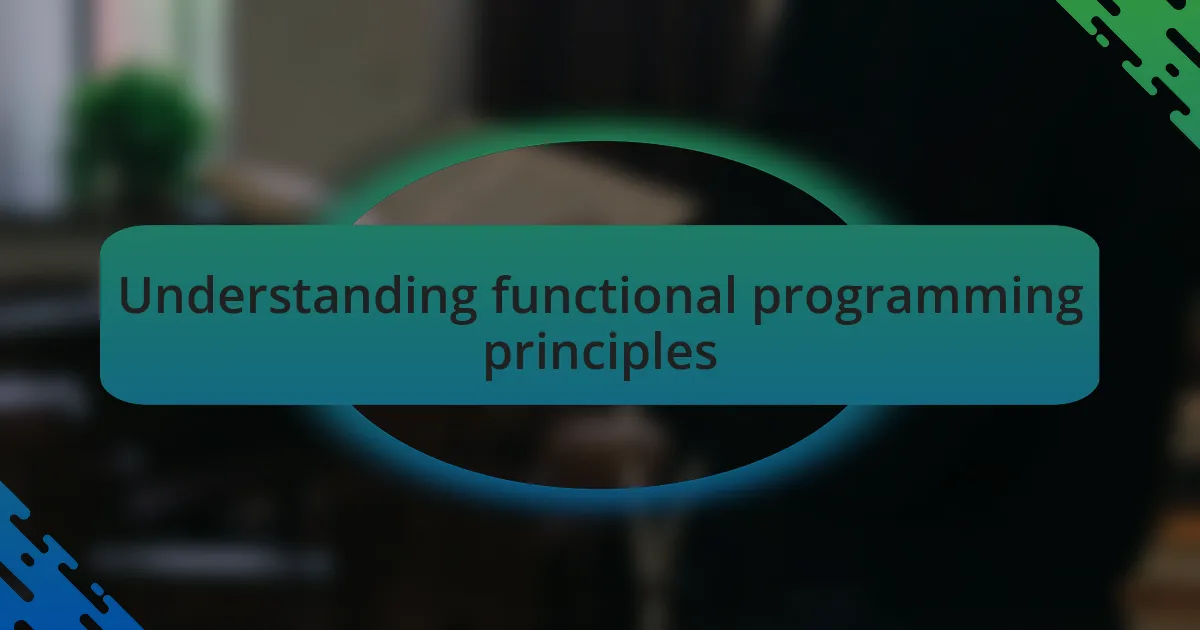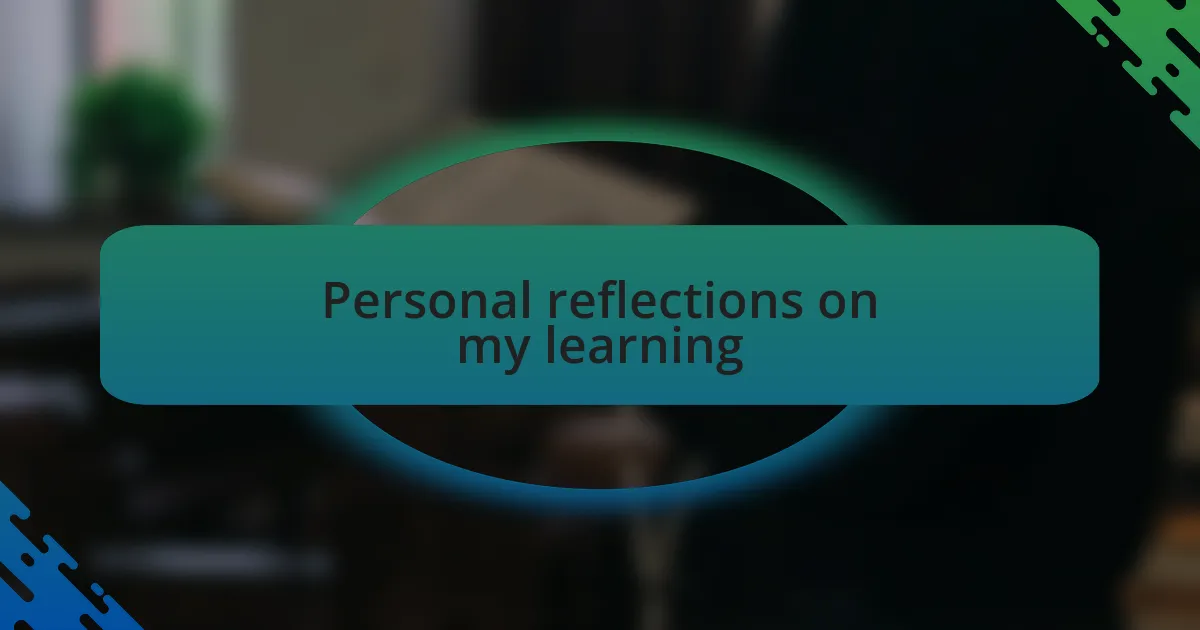Key takeaways:
- Functional programming emphasizes immutability and pure functions, leading to cleaner, more manageable code and easier debugging.
- F# features like powerful type inference and pattern matching enhance coding efficiency and expressiveness compared to other languages.
- Transitioning to F# from imperative languages can be challenging due to its syntax, functional paradigm, and concepts like discriminated unions and asynchronous workflows.
- Supportive online communities play a crucial role in overcoming learning hurdles and making the programming journey more collaborative and less isolating.

Understanding functional programming principles
Functional programming is rooted in the idea of treating computation as the evaluation of mathematical functions. When I first encountered this principle, it felt like discovering a hidden layer of logic in programming; the beauty lies in avoiding changing state and mutable data. I remember the moment I wrote my first pure function—it was exhilarating.
One of the core principles is immutability, which often left me wondering why it wasn’t emphasized more in traditional programming courses. When I began using immutable data structures, I felt a newfound clarity emerge in my code. It dawned on me that without the side effects of mutable states, debugging became a breeze. Have you ever attempted to trace a bug in a large, stateful system? It can be a daunting task.
Another fascinating concept in functional programming is first-class functions, which means functions can be treated as values. I recall a time when I used this principle to create higher-order functions, allowing me to abstract away complex behaviors effectively. It was a game-changer. Have you ever thought about how you can pass functions around just like variables? This flexibility opens up a world of possibilities in your code, making it more modular and reusable.

Exploring the F# language features
F# offers a unique blend of functional programming features that can enhance one’s coding experience. For instance, its powerful type inference system often left me in awe as I saw how it effectively eliminates the need for excessive type annotations. The first time I discovered how F# could infer types automatically, I felt this relief wash over me; I could focus on writing clean code without getting bogged down by verbose syntax.
The pattern matching feature in F# is another standout. I remember wrestling with multiple conditional statements in other languages and then being pleasantly surprised by how elegantly F# handled complex data structures through pattern matching. The clarity and expressiveness it brings to the code can make developers feel almost like artists, painting their logic with strokes that are both precise and beautiful. Have you ever witnessed your logic flow seamlessly because of a simple, well-placed pattern match?
Moreover, F# promotes a functional-first approach, but it also integrates with object-oriented features, creating a rich environment for developers. I vividly recall a project where I combined functional and object-oriented paradigms, resulting in a flexible design that could evolve over time. It was a remarkable experience to see how smoothly the two worlds coexisted within F#, enabling me to write code that was both robust and adaptable. This versatility truly emphasizes why F# is a compelling choice for developers interested in advancing their functional programming skills.

Comparing F# with other languages
F# stands out when compared to languages like Java or C#. While those languages often rely heavily on imperative paradigms, F# embraces a functional-first approach that radically changes how I approach problem-solving. I remember a project where I switched from C# to F#, and it felt like I had stepped into a new realm of efficiency; my logic became clearer, and I could express complex operations with fewer lines of code. Have you felt that sense of liberation when your code flows effortlessly?
When I reflect on comparing F# with Python, the distinction in handling data manipulation becomes apparent. In Python, I often found myself writing intricate loops to process collections, which sometimes felt clunky. In F#, though, using higher-order functions to work with lists felt like a breath of fresh air. I still recall that moment of joy when I first transformed a collection with a simple map function; it felt so intuitive and elegant that I wondered why I hadn’t adopted this approach sooner.
Against the backdrop of languages like JavaScript, F# offers a more robust type system that can lead to fewer runtime errors. I’ve experienced the frustration of debugging JavaScript, only to find a subtle typo causing a cascade of failures. With F#, knowing that I have a strong type check before the code even runs gave me immense peace of mind. It’s like having a safety net that allows me to explore more complex logic without the fear of unexpected crashes. Have you ever wished your programming journey could be that secure?

Challenges faced while learning F#
One of the primary challenges I faced when learning F# was getting accustomed to its syntax and functional paradigm. Coming from an imperative background, I often found myself trying to force a stateful approach onto the language, and that just doesn’t work in F#. I clearly remember the frustration of encountering compiler errors that stemmed from not fully grasping how functional programming emphasizes immutability. Have you ever felt that nagging sense of confusion over syntax that keeps you from moving forward?
Another hurdle was understanding the concept of discriminated unions. Initially, I approached data types with a “standard” object-oriented mindset, and discovering how to represent complex data structures in F# felt like deciphering a new language within a language. The first time I successfully implemented a discriminated union, there was a profound sense of accomplishment, but getting to that point required patience and plenty of trial and error. Does it resonate with you when you finally grasp a complex concept that initially seemed daunting?
Lastly, I often struggled with asynchronous workflows, especially when integrating them into my applications. The non-linear nature of F# asynchronous programming was a stark departure from my previous experiences, and it took time for me to appreciate the flow of computations in a functional context. I vividly recall a late-night coding session where everything clicked into place, transforming what felt like chaos into a harmonious flow of processes. Have you experienced that moment when all the pieces come together, shifting your perspective on programming?

Personal reflections on my learning
As I dove deeper into my F# learning journey, I began to appreciate the beauty of its functional style. I distinctly remember the moment I realized that pure functions could lead to cleaner and more predictable code. It felt like a revelation; have you ever had an epiphany where everything suddenly makes sense, reshaping how you view your entire coding practice?
One memory that stands out is the challenge I faced while trying to embrace recursion. Initially, I was hesitant, often defaulting to iteration due to its familiarity. However, after hours of experimentation, I finally got a recursive function to work, and it was exhilarating. That breakthrough taught me that stepping out of my comfort zone would lead to immense growth—do you find that sometimes discomfort paves the way for meaningful insights?
Reflecting on my learning experiences, I can’t help but think about the supportive online community I discovered along the way. Participating in forums and coding groups allowed me to find guidance and share my struggles, which made the learning curve feel less isolating. It’s intriguing how connecting with others can transform solitary challenges into shared learning experiences, isn’t it?